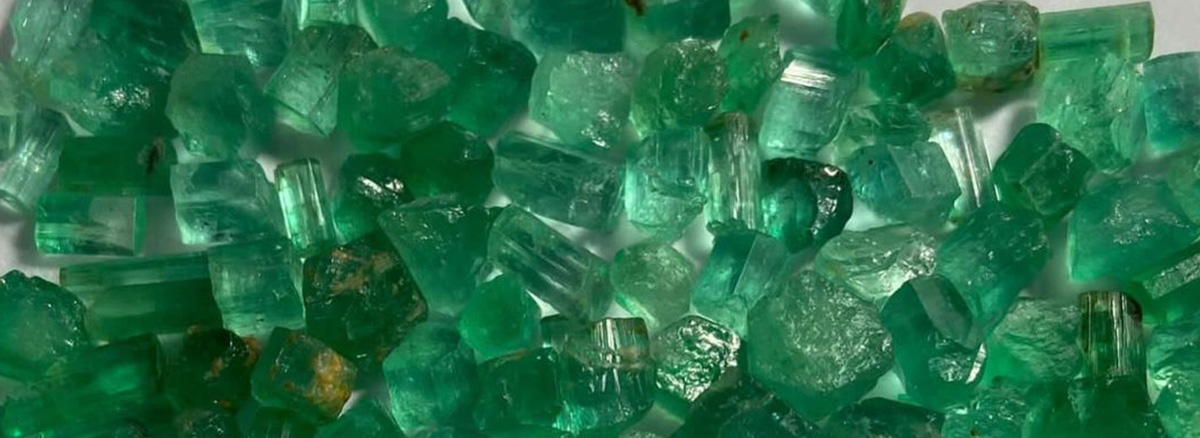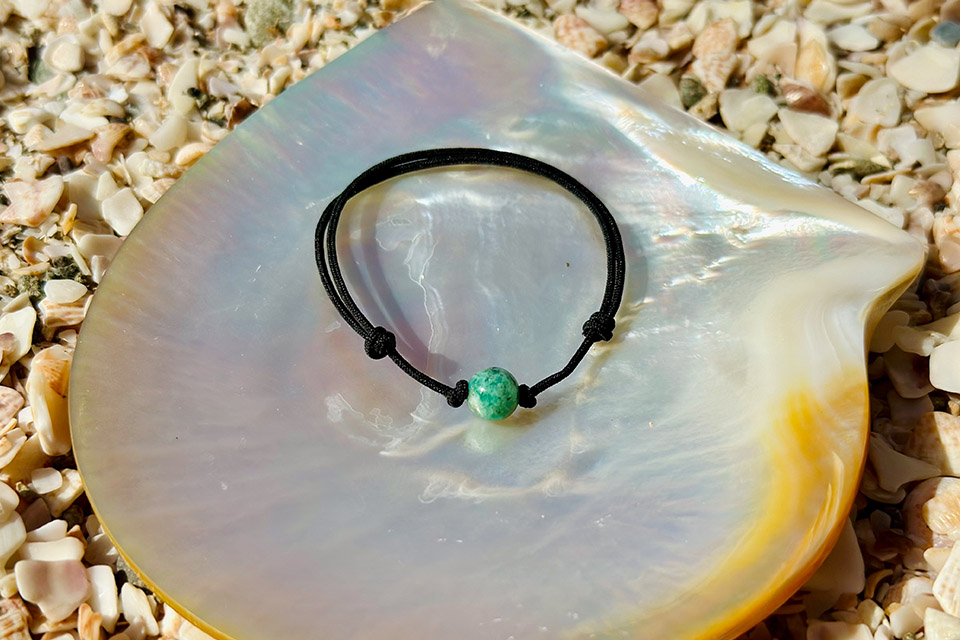The Emerald
Emerald, with its captivating green color, is a gemstone that has fascinated and charmed humanity for millennia. Revered for its lush beauty and mysterious luster, emerald is not only a symbol of wealth and prestige, but it also holds a special place in the history and culture of many civilizations.

LITTLE HISTORY ABOUT THE EMERALD!
Historically, emeralds were sought after by kings and queens for their deep green color, often associated with fertility, rebirth, and eternal life. This gemstone has been a central part of many ancient cultures, ranging from the Incas of South America, who revered it as a sacred symbol, to the Egyptians, where the famous Cleopatra was known for her passion for these green gems. In stories and legends, emerald has often been shrouded in mystery and magical powers.
It was believed to offer prophecy, protection from disease, and even the ability to see into the future. Its green hue is also closely linked to nature, symbolizing regeneration and revitalization. Today, emerald continues to capture our imagination. It is synonymous with luxury, sophistication and refined taste in the world of fine jewelry. Its presence in natural jewelry, from elegant rings to opulent necklaces, continues its legacy as one of the most precious and desired gems in the world.
PHYSICAL AND CHEMICAL PROPERTIES OF EMERALD
PHYSICAL CHARACTERISTICS :
Emerald is a vibrant green gemstone that is distinguished by its unique color that varies from pale green to intense dark green. Its color is mainly due to the presence of traces of chromium and sometimes vanadium. In terms of hardness, emerald ranks around 7.5 to 8 on the Mohs scale, making it hard enough to use in jewelry, but soft enough to require special care when handling.
CRYSTALLINE STRUCTURE:
Emerald belongs to the beryl family and is characterized by its hexagonal crystal structure. This structure can often include internal inclusions and fractures, known as the “emerald garden.” These characteristics are not only accepted, but often appreciated because they make each stone unique.
CHEMICAL COMPONENTS AND GEOLOGICAL FORMATION:
Chemically, emerald is a beryllium aluminum silicate. It forms in metamorphic rocks under high pressure and high temperatures. These conditions are often found near geological sites where tectonic plates meet, explaining the rarity and limited geographic distribution of high-quality emerald deposits.
WHAT ARE THE ORIGINS AND MAIN DEPOSITS OF EMERALD?
Emerald is a global gem, mined in several regions across the globe, each offering distinct characteristics to its stones. Colombian emeralds are known for their pure, deep green color. It is one of the most prestigious sources of emeralds in the world, with famous deposits like Muzo and Chivor. The reputation of Colombian emeralds is based on their rich, saturated color which is often considered the benchmark for quality.
Brazil is another major player in the world of emeralds, known for the wide variety of shades and qualities available. Brazilian deposits often produce emeralds with slightly more yellowish or bluish hues, offering an interesting alternative to classic hues. Zambian emeralds are increasingly prized for their exceptional quality and unique color. Often intense green and slightly bluish, they are appreciated for their clarity and transparency comparable to those of the best Colombian emeralds.
You should know that each source of emerald has its own characteristics which influence the appearance and value of the stone:
- Colombian emeralds are often mined in limestone veins, contributing to their classic green color and clarity.
- Brazilian deposits are often found in granite formations, offering a wide range of qualities and allowing large-scale production.
- Zambian emeralds form in metamorphic shales, which often gives them a darker hue and greater transparency.
Knowing the origin of an emerald is essential to understanding its value and rarity. Whether you are a collector, investor or simply a lover of beautiful stones, the provenance of an emerald adds a fascinating dimension to its beauty and history.
THE COLOR OF EMERALD AND ITS EVALUATION
This natural gem is famous for its spectacular array of green shades. This color can vary from a pale, almost transparent green to a deep, rich green. The ideal shade is often described as a vibrant green with a slight hint of blue, reminiscent of the color of young leaves in spring. Darker, more saturated shades are generally the most popular, although preference for a specific shade can vary based on personal taste and cultural trends.
Color is one of the main factors that determine the value of an emerald. Stones with an intense, uniform color and without areas of color or too pronounced areas of clarity are the most sought after and, therefore, the most expensive. Color saturation and vibrancy are also crucial; an emerald with a deep, saturated color will generally be valued more highly than a lighter or duller stone.
The best quality emeralds display a rich, even green color without being too dark or too light. It is important to note that the color must be viewed under natural or equivalent light to fully appreciate its nuance. Additionally, the way the stone is cut can also affect its color; proper cutting can improve the color and shine of the stone.
The color of the emerald is therefore an essential element to take into account when evaluating this precious stone. It not only determines the aesthetic appeal of the gem, but also its rarity and market value. Choosing this gem for its color is a matter of personal taste, but also an understanding of what makes a stone a high-quality specimen.
THE HISTORY AND MYTHOLOGY OF THE EMERALD
THE FASCINATING VIRTUES OF EMERALD IN LITHOTHERAPY
This gem has always held pride of place in various cultures for its purported healing properties. The ancient Egyptians, for example, used emerald to promote fertility and regeneration. In medieval Europe, it was believed that emerald could cure illnesses and ward off evil spirits. In lithotherapy, emerald is particularly known for its influence on emotional balance. It is attributed with the ability to soothe strong emotions, to promote a feeling of compassion, harmony and unconditional love.
For those who are going through periods of intense stress or negative emotions, emerald can be a support to find serenity and balance. this natural stone is also said to stimulate mental clarity and wisdom. It is often recommended for those looking to improve their ability to concentrate, their memory and their intellectual understanding. In a professional or academic context, wearing an emerald can therefore prove beneficial.
PHYSICAL PROPERTIES OF THIS NATURAL STONE
On a physical level, emerald has traditionally been associated with healing and strengthening the immune system. It is also believed to have beneficial effects on the eyes and vision, a legacy from antiquity where it was used to treat various eye disorders.
EMERALD AND SPIRITUALITY
When it comes to spirituality, emerald is often used to open and nourish the heart chakra. It is known to aid spiritual growth, meditation and connection with the natural universe. By acting on this chakra, emerald promotes openness to love, both in terms of giving and receiving. It is essential to remember that crystal healing does not replace professional medical advice, but can be used as a complement to improve general well-being.
St-Barthélemy
23 Rue du Général De Gaulle, Gustavia
97133 Saint Barthélemy
+59 0690 6593 00
HOURS
Monday to Saturday
9:30 AM ~ 8:00 PM
St-Tropez
13 quai Epi, Saint-Tropez
83990 France
+33 4 94 43 47 62
HOURS
Monday to Saturday
9:30 AM ~ 8:00 PM






